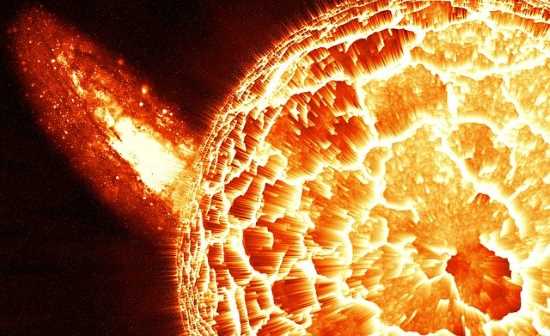Your kid must have troubled you with so many questions about the earth, about the Sun, about the moon, about the solar system, about space, and about how everything came in this world. Parents come in a dilemma when kids ask questions that are hard to explain because the child is not cognitively developed to understand it. But When it is about the Sun, parents can refer to this article to tell the kid facts about the Sun. In this article you will know the 50 facts about the Sun, you will be able to tell amazing facts about the Sun to your kid to increase their knowledge and to tell them important information that the child should remember.
What are the Facts about the Sun?
Below are some interesting facts about the sun that will make your kid “woo”. It will be great to know how your kid will further question you to find out in-depth information about the same.

Did You Know these Facts about the Sun?
#1 Gravity of the Sun is 28 times stronger than the Earth’s planets
#2 Without Sun, Our Earth Would travel in the straight line
#3 All the planets revolve around the sun, hence it is called the centre of the solar system
#4 The gravity of it holds the earth and all the other planets together in a confined area known as the solar system.
#5 The heliosphere is the bubble that surrounds the sun and solar system.
#6 if you want to study the interior of the sun, then that study is called Helioseismology
#7 Many satellites, the most important of which is the SOHO, are used to study it (Solar and Heliospheric Observatory)
#8 One million Earths will account for 0.00033 percent of all stars in the Milky Way.
#9 It contains electric currents that create a magnetic field that extends across the solar system.
#10 A worldwide disturbance of the earth’s magnetic field which is called a geomagnetic storm is the result of solar activity.
Also Read: Introduction to Fraction: How to Explain Fractions to a Child?
Check out Facts from 11 to 20
#11 By a mechanism known as photosynthesis, it generates energy that sustains all life on Earth.
#12 Its Energy is produced from the Fusion of Hydrogen into Helium
#13 It has a temperature of between 5500 and 6000 degrees Celsius.
#14 Because of its temperature and pressure, nuclear reactions occur within its nucleus.
#15 It produces three types of energy: infrared radiation, visible light, and ultraviolet light.
#16 The ozone layer blocks the majority of its ultraviolet rays, which cause sunburn.
#17 UV rays from the sun are also antiseptic.
#18 Radiation is the mechanism by which energy travels from it to the earth.
#19 It takes a million years for heat and energy emitted from its core to reach its surface.
#20 A solar flare occurs when magnetic energy that has been building up in its atmosphere is unexpectedly released, causing a rapid variation in brightness.
Check out Facts from 21 to 25
#21 The amount of energy emitted during a flare is the equivalent of millions of 100-megaton hydrogen bombs exploding at the same time.
#22 This explosion is ten million times more powerful than a volcanic eruption, but it only accounts for one-tenth of the total energy released by the sun per second.
#23 It is simply a combination of ALL colours that appears white to the naked eye.
#24 Because of a process known as atmospheric scattering, it appears to be several different colours during the day.
#25 It could hold over a million Earths. If you filled a hollow Sun with spherical Earths, about 960,000 would fit inside. However, if those piles of earth were squashed to ensure there was no wasted space, you could fit 1,300,000 piles of earth within the Sun. Its surface area is 11,990 times that of Earth.
Also Read:- Efficient Way to Learn English: A Session for Non-English Speaking Kids
Check out Facts from 26 to 28
#26 It is moving at a speed of 220 kilometres per second. It is about 24,000-26,000 light-years from the galactic centre and takes the Sun approximately 225-250 million years to complete one orbit of the Milky Way’s centre.
#27 The Earth from the Sun takes 8 minutes to get the rays. The average distance between the Sun and the Earth is approximately 150 million kilometres. Light travels at a speed of 300,000 km per second, so dividing one by the other yields 500 seconds – eight minutes and twenty seconds. This energy can hit Earth in a matter of seconds, but it takes millions of years to migrate from its centre to its surface.
#28 It has completed half of its life cycle. At 4.5 billion years old, It has burned through about half of its hydrogen reserves and still has enough to burn for another 5 billion years. It is now a yellow dwarf star.

Check Out Facts from 29 to 31
#29 The distance between the Earth and the Sun varies. This is because the Earth orbits the Sun in an elliptical orbit. The difference between the two is between 147 and 152 million kilometres. They are separated by one Astronomical Unit (AU).
#30 It has a very strong magnetic field. As it releases magnetic energy during magnetic storms, solar flares occur, which we see on Earth as sunspots. Sunspots are dark spots on the surface of the Sun caused by magnetic changes. They appear dark because their temperature is much lower than the surrounding areas.
#31 Within the Sun, temperatures can exceed 15 million degrees Celsius. It generates energy from nuclear fusion in its centre (when hydrogen converts to helium), and since things normally expand, the Sun would burst like a massive bomb if it weren’t for its immense gravitational pull.
Also Read:- Idioms and Phrases in English for Kids: Don’t Miss out on the Important Idioms and Phrases
Check Out Facts from 32 to 34
#32 Solar winds are produced by the Sun. These are plasma ejections (extremely hot charged particles) that originate in its corona and can travel up to 450 km per second across the solar system.
#33 The Earth will be consumed by the Sun one day. After it has burned out all of its hydrogens, it will continue to burn helium for another 130 million years. During this time, it will develop to the point that it will engulf Mercury, Venus, and Earth. It will have evolved into a red giant star by the time it reaches this stage.
#34 Aristarchus of Samos, a Greek astronomer and mathematician, was the first to propose that it is the nucleus in which planets orbit. Between 310 BC and 230 BC, the hypothesis was introduced.

Check Out Facts from 35 to 38
#35 The Daniel K. Inouye Solar Telescope took the highest-resolution picture of the Sun ever taken on December 10, 2019. The image depicts the surface of the Solar System’s star divided into tiny popcorn-line cells, with plasma growing high into the solar atmosphere. Maui, Hawaii, is the location of the optical instrument.
#36 It is known by 12 different names and meanings in Indian astrology, reflecting the 12 months of the year: Mitra (The Friend), Ravi (The Radiant), Surya (Giver of Beauty), Bhanu (Emotional Catalyst), Khaga (Awesome), Pushna (Nourisher), Hiranya Garba (The All-Inclusive), Marica (Destroyer of Darkness), Aditya (Illuminator of the Way), Savitra (The Arouser), Arka (Flash of Warmth), and Bhaskar
#37 It accounts for approximately 99.86 percent of the total mass of the solar system.
#38 Stonehenge, constructed between 3,000 and 2,000 BC, is aligned such that it rises directly over the heel stone on the solstice, and the first rays shine through the middle of the stone circle.
Also Read:- Teaching Critical Thinking to Children: Games, Activities, and Books
Check Out Facts from 39 to 42
#39 Gravitational energy is transformed into heat when the Proto-Stars collapse, causing the Proto-Star to glow red. It condenses further until nuclear reactions within its core stop the gravitational collapse. This indicates that the Proto-Star has evolved into a Star and is now in its Main Sequence.
#40 Our Sun, at 4.6 billion years old, is in the Main Sequence and is considered a middle-aged star. This means it has reached the halfway point of its existence and is now regarded as a Yellow Dwarf.
#41 It is surrounded by a plasma aura known as a ‘corona,’ which is Latin for ‘crown.’ Its corona extends millions of kilometres into space and is best seen during a total solar eclipse.
#42 However, there is a specialised form of telescope known as a ‘coronagraph’ that can see objects very close to it, such as its corona, other planets, and sun-grazing comets. It functions by obscuring its bright surface with a disc.

Check Out Facts from 43 to 45
#43 While the average distance between the Sun and the Earth is 150 million kilometres, the distance varies annually. This is due to the Earth’s elliptical orbit around the Sun, which means the distance between the two ranges between 147 and 152 million kilometres. An Astronomical Unit is the distance between the Sun and the Earth (AU).
#44 The number of Sunspots that appear on the Sun varies greatly, with a peak number of Sunspots visible every 11 years. This suggests that the Sun has a behaviour pattern that repeats itself every 11 years.
#45 It has had a major impact on many ancient religions throughout history. Many early civilizations worshipped it as a goddess because it was also regarded as the giver of life. The Egyptians worshipped a Sun God named Ra, while the Aztecs worshipped a Sun God named Tonatiuh.
Check Out Facts from 46 to 50
#46 We would only see darkness if the it’s bright surface were gone. Its outer surface is bright enough to melt your retinas, but its centre is pitch black.
#47 Solar winds are also responsible for some of the space’s most beautiful phenomena, such as comet tails and the Aurora Borealis, or The Northern Lights.
#48 Its surface temperature is about 5,500 degrees Celsius, which seems cool in contrast to the core’s temperature.
#49 Its polar diameter is opposed to its equatorial diameter, the difference is just 10 kilometres. This means that it is almost a perfect sphere.
#50 If you flew to the Sun at its normal speed (about 644km/h), it will take you 20 years to get there without stopping!
Conclusion
The importance of the Sun is not hidden from anybody, and it is important for us to know about it as much as we can. Kids often ask questions about the sun, the moon, the solar system, and space. In this article, you will get information about the sun. you will get amazing facts about the sun that you can tell your kid and increase their knowledge about the sun and its relation with the earth. Kids should know why the sun is important and what power it has and how it moderates the earth. Do share your thoughts about this article in the comment section below and for more interesting articles, keep your eye here.







